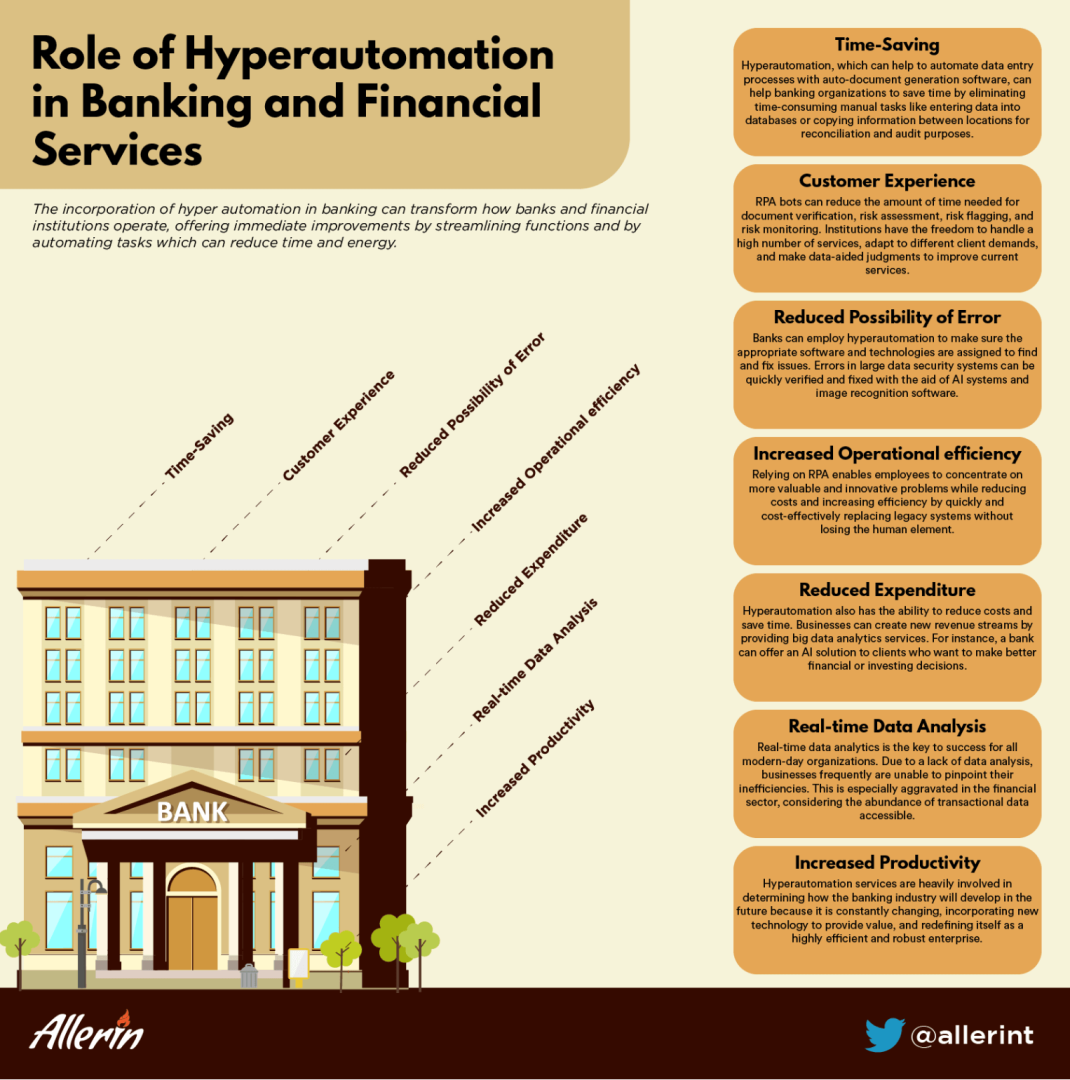Comments
- No comments found

The incorporation of hyperautomation in banking is a game changer.
It will transform how banks and financial institutions operate, offering immediate improvements by streamlining functions and by automating tasks which can reduce time and energy.
Financial services have always been an industry that uses large volumes of data for all decisions. The operations in the financial sector have always been where even a small mistake can have a domino effect on many other processes, potentially leading to catastrophic results for individuals and institutions. The introduction of technological interventions is helping minimize such risks.
Hyperautomation can be integrated into various banking processes such as payments, account administration, and back-office tasks, including risk management and credit scoring. Several financial companies have come to understand the true potential of hyperautomation and are now using it in their services to offer contactless payments and QR scanning ability to their customers. Financing sectors are also using RPA in the insurance sector. But before discussing the benefits of or the role of hyperautomation in financial services, it is important to first understand what hyperautomation exactly is.
Hyperautomation combines technologies like artificial intelligence (AI), robotic process automation (RPA), natural language processing (NLP), machine learning (ML), business process management (BPM), and other automation tools with the purpose of automating crucial processes. While tackling the immediate problems of the financial system with automation, banks and other financial institutions have now turned to hyperautomation to gain more significant advantages.
The banking, financial services, and insurance industries are seeing an increase in the adoption of hyperautomation to rethink the way operations are carried out while enhancing efficiency, profitability, speed, accuracy and resilience. Businesses can efficiently onboard new customers, provide reports, manage data, and automate transactions using RPA and machine learning technologies.
Banks must provide their services effectively to lower the risk of loss or delay while continuing their expansion plans. This is where hyperautomation can make things easier for the financial service sector.

One of the most critical resources available to enterprises is time. Hyperautomation, which can help to automate data entry processes with auto-document generation software, can help banking organizations to save time by eliminating time-consuming manual tasks like entering data into databases or copying information between locations for reconciliation and audit purposes.
Banks can provide an enhanced client experience at all levels by leveraging data to create enduring connections between banks and customers. RPA streamlines even document-intensive processes like KYC, redefining onboarding as a hassle-free digital experience.
RPA bots can reduce the amount of time needed for document verification, risk assessment, risk flagging, and risk monitoring. Institutions have the freedom to handle a high number of services, adapt to different client demands, and make data-aided judgments to improve current services.
Banks can provide better services to clients by reducing system failures, thanks to hyperautomation. Banks can employ hyperautomation to make sure the appropriate software and technologies are assigned to find and fix issues. Errors in large data security systems can be quickly verified and fixed with the aid of AI systems and image recognition software. Better customer service and a reduction in errors are just a few of the outcomes of hyperautomation in financial services.
Banks can improve client relations, streamline processes, and enhance the entire customer experience by implementing hyperautomation technologies. Backend operations gain enhanced accuracy, timeliness, reliability, and a high degree of flexibility by utilizing simple, no-code solutions. The resulting adaptability enables banks to expand operations without making additional resource and infrastructure investments, increasing ROI and profitability.
Relying on RPA enables employees to concentrate on more valuable and innovative problems while reducing costs and increasing efficiency by quickly and cost-effectively replacing legacy systems without losing the human element. Automating cross-functional tasks promotes collaboration and communication, aligns teams and processes, fosters accountability, uncovers new opportunities, and boosts productivity, all of which contribute to operational effectiveness and profitability.
Hyperautomation also has the ability to reduce costs and save time. Businesses can create new revenue streams by providing big data analytics services. For instance, a bank can offer an AI solution to clients who want to make better financial or investing decisions. The bank might then utilize this information to make money by selling these insights to other clients, thereby benefiting all parties.
Real-time data analytics is the key to success for all modern-day organizations. Due to a lack of data analysis, businesses frequently are unable to pinpoint their inefficiencies. This is especially aggravating in the financial sector, considering the abundance of transactional data accessible.
By assisting IT decision-makers in releasing the full potential of data and gaining insights that help them comprehend current business patterns and forecast future outcomes, hyperautomation has the potential to revolutionize the financial services industry. They are, therefore, in an excellent position to improve their automated procedures and make the required course modifications. As a result, businesses can evolve and adapt in real-time to the shifting consumer landscape.
In addition, banks can effectively monitor all financial transactions and proactively spot any fraudulent activity by utilizing AI algorithms and machine learning solutions incorporated into hyperautomation. Machine learning-based predictive models created using sophisticated modeling approaches can reduce client risks by predicting the likelihood of fraudulent transactions.
Employees can spend more time on creative work and less time on menial activities because there is no need for supervision or human involvement. The repetitive processes will be handled by the RPA agents or automation software, increasing both the business and employee productivity.
Hyperautomation services are heavily involved in determining how the banking industry will develop in the future because it is constantly changing, incorporating new technology to provide value, and redefining itself as a highly efficient and robust enterprise. The changes in the entire business ecosystem will impact the economy's future, redefining banking while enhancing efficiency and customer experience.
The goal of hyperautomation is to do low-value jobs using automation technologies, cutting-edge AI, and machine learning, enabling systems to operate automatically and effectively with essentially no human involvement. It will aid in expanding businesses and form a working ecosystem that is always learning, adaptable, and prepared to use data and insights for rapid and precise decision-making. There has never been a better opportunity to embrace the future of intelligent automation as financial organizations strive to remain competitive in an increasingly uncertain landscape.
Naveen is the Founder and CEO of Allerin, a software solutions provider that delivers innovative and agile solutions that enable to automate, inspire and impress. He is a seasoned professional with more than 20 years of experience, with extensive experience in customizing open source products for cost optimizations of large scale IT deployment. He is currently working on Internet of Things solutions with Big Data Analytics. Naveen completed his programming qualifications in various Indian institutes.
Leave your comments
Post comment as a guest